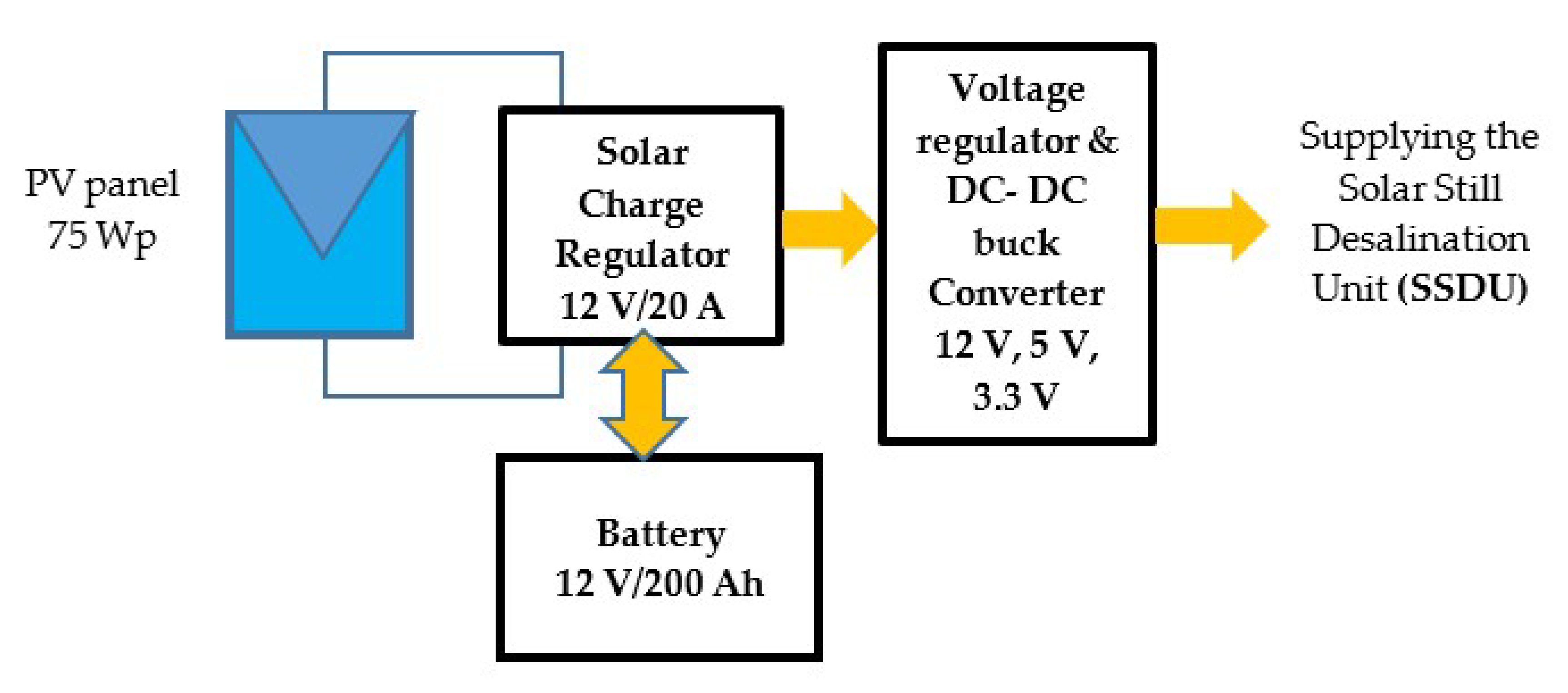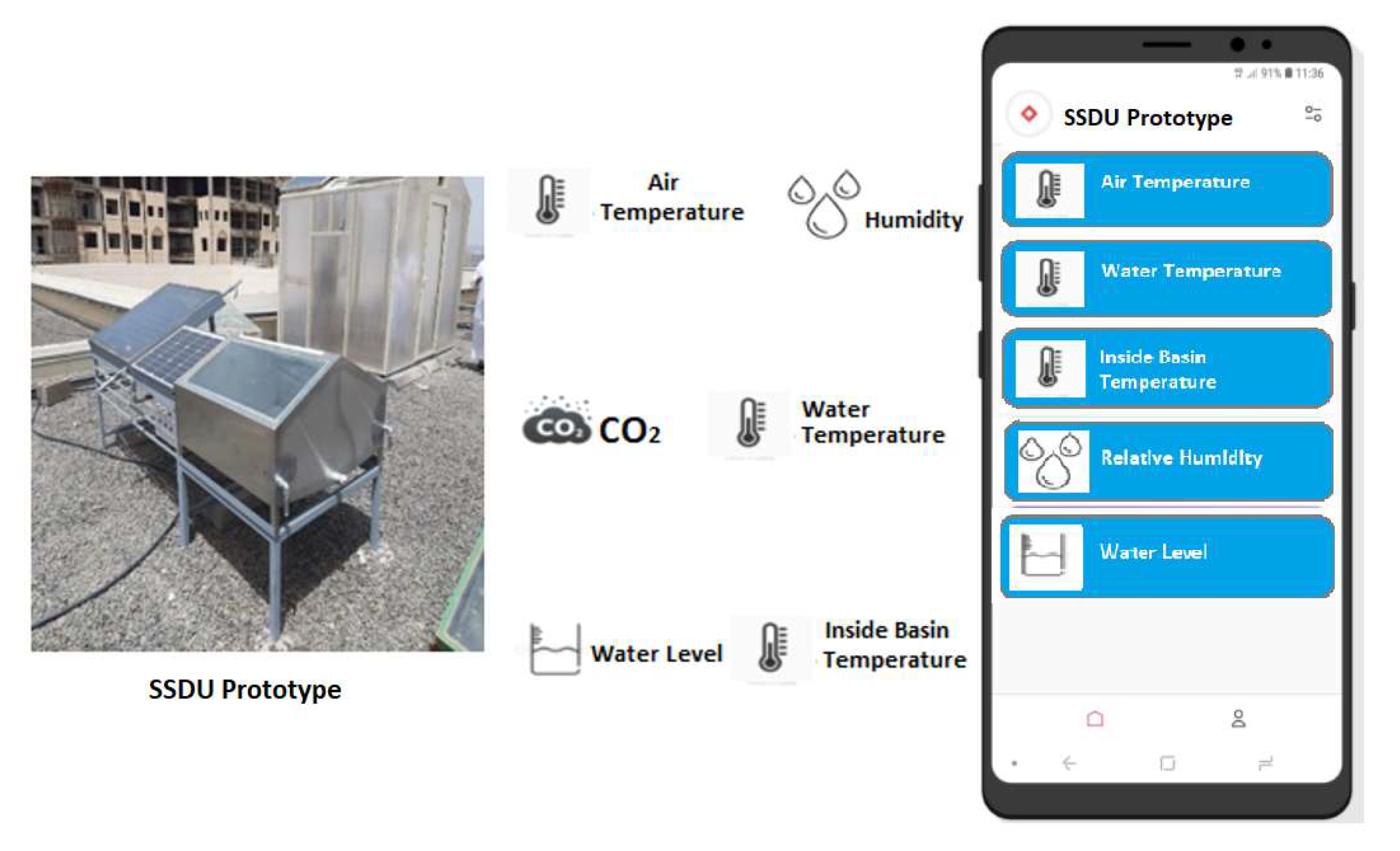Monitoring of Solar Still Desalination System Using the Internet of Things Technique
Abstract
1. Introduction
2. Materials and Methods
- A basic solar still that was fabricated with inner dimensions of 1 m × 1 m (effective area of 1 m2) and the glass cover was tilted at 25° with respect to the horizontal;
- A solar heater for preheating water, which was designed with an area of 1 m2 × 10 cm formed by copper tubes, as shown in the following diagram;
- A monitoring system used for data acquisition and parameter control using the IoT technique;
- A PV system of 75 Wp capacity was used for supplying different components of the system.
- Initially, the tank (containing salt water) is considered full (500 L) as well as the basin (100 L);
- The water position in the basin is checked, which should be between two levels (L1 = 2 cm and L2 = 10 cm); if the position sensor indicates that the measured level is less than L1, the microcontroller activates the relay and the valve will be opened till the water level L2 is reached; then, the relay is activated automatically by sending a signal from the microcontroller;
- The water level in the tank is verified; if the level is less than L3 = 500 L, the microcontroller sends a signal to start the water pump, till the L3 is reached;
- The Wi-Fi module is programmed to send the measured parameters to the cloud every 5 min, via the IoT technique [13];
- If the system stops, an anomaly occurs or no distiller water is produced, the user is alerted by a simple SMS via a phone.
2.1. Monitoring and Displaying Solar Still Desalination Parameters
- Sensors (ambient temperature, relative humidity, inside temperature, water temperature, water level and amount of distilled output water);
- Actuators (valve and water pump);
- Liquid crystal display (LCD) permits us to visualize the measured data;
- A low-cost microcontroller (Arduino Mega 2560) is used to control and monitor different parameters inside and outside the solar still desalination unit. The parameters monitored are Ta, Tstill, RH, Tw, WL and Wd (daily amount of output distilled water).
- Step #1: Initialization and loading of reference parameters (Tref, RHref and WLref), which are based on experimental thresholds.
- Step #2: Measuring real parameters (Ta, Tstill, RH, Tw, WL and Wd).
- Step #3: Sending signal to the actioners by activating the corresponding relay:
- -
- Water pump: start filling the tank.
- -
- Valve: start filling the solar basin.
2.2. Webpage Development
2.3. Mobile Application
2.4. Stand-Alone Photovoltaic System
3. Results and Discussion
3.1. Designed Prototype
3.2. Data Visualization Monitoring
3.3. Warning SMS
3.4. Mobile Application
3.5. Effects of Different Parameters on the Yields of Distilled Output Water
3.6. Cost Calculation of Solar Stills
4. Conclusions
Author Contributions
Funding
Institutional Review Board Statement
Informed Consent Statement
Data Availability Statement
Acknowledgments
Conflicts of Interest
Abbreviations
| Cs | Capital cost |
| CSS | Cascading Style Sheets |
| DC | Direct current |
| EC | Electrical conductivity |
| GSM | Global System for Mobile Communications |
| IoT | Internet of Things |
| LED | Light-emitting diode |
| LCD | Liquid crystal display |
| MENA | Middle East and North Africa |
| Myearly | Average annual productivity of distilled water |
| NodeMCU | Node microcontroller unit |
| pH | pH is a scale used to specify the acidity or basicity of an aqueous solution |
| PV | Photovoltaic |
| RH | Relative humidity |
| RHref | Reference value of relative humidity |
| SAPV | Stand-alone PV system |
| SMS | Short Message Service |
| SSDU | Solar still desalination unit |
| Ta | Air temperature (ambient) |
| TAC | Total annual cost |
| TDS | Total dissolved solids |
| Tstill | Temperature inside the still |
| Tref | Reference value of temperature |
| Tw | Water temperature |
| UCdw | Unit cost of desalination of saline water |
| WL | Water level |
| WLref | Reference value of water level |
| Wd | Distilled water (output water) |
| Wp | Watt pick (maximum power of PV panel) |
References
- Kalankesh, R.; Rodríguez-Couto, L.; Zazouli, M.A. Desalination and power generation of Caspian sea by applying new designed microbial desalination cells in batch operation mode. Environ. Prog. Sustain. Energy 2019, 38, 13205. [Google Scholar] [CrossRef]
- Khanmohammadi, S.; Khanjani, S. Experimental study to improve the performance of solar still desalination by hydrophobic condensation surface using cold plasma technology. Sustain. Energy Technol. Assess. 2021, 45, 101129. [Google Scholar] [CrossRef]
- Ghaffour, N.; Lattemann, S.; Missimer, T.; Ng, K.C.; Sinha, S.; Amy, G. Renewable energy-driven innovative energy-efficient desalination technologies. Appl. Energy 2014, 136, 1155–1165. [Google Scholar] [CrossRef]
- Manchanda, H.; Kumar, M. Study of water desalination techniques and a review on active solar distillation methods. Environ. Prog. Sustain. Energy 2018, 37, 444–464. [Google Scholar] [CrossRef]
- Hansen, R.S.; Murugavel, K.K. Enhancement of integrated solar still using different new absorber configurations: An experimental approach. Desalination 2017, 422, 59–67. [Google Scholar] [CrossRef]
- Naroei, M.; Sarhaddi, F.; Sobhnamayan, F. Efficiency of a photovoltaic thermal stepped solar still: Experimental and numerical analysis. Desalination 2018, 441, 87–95. [Google Scholar] [CrossRef]
- Moungar, H.; Azzi, A.; Sahli, Y.; Hieda, A. Double slope solar still with immersed fins: Theoretical and experimental study. Univ. Politeh. Buchar. Sci. Bull. Ser. C-Electr. Eng. Comput. Sci. 2018, 80, 231–246. [Google Scholar] [CrossRef]
- Abed, F.M.; Eleiwi, M.A.; Hasanuzzaman, M.; Islam, M.M.; Mohammed, K.I. Design, development and effects of operational conditions on the performance of concentrated solar collector-based desalination system operating in Iraq. Sustain. Energy Technol. Assess. 2020, 42, 100886. [Google Scholar] [CrossRef]
- Mirmanto, I.; Adi Sayoga, M.; Tri Wijayanta, A.; Pulung Sasmito, A.; Muhammad Aziz, M. Enhancement of Continuous-Feed Low-Cost Solar Distiller: Effects of Various Fin Designs. Energies 2021, 14, 4844. [Google Scholar] [CrossRef]
- Radomska, E.; Mika, L.; Sztekler, K.; Kalawa, W. Experimental Validation of the Thermal Processes Modeling in a Solar Still. Energies 2021, 14, 2321. [Google Scholar] [CrossRef]
- Yousefi, H.; Aramesh, M.; Shabani, B. Design Parameters of a Double-Slope Solar Still: Modelling, Sensitivity Analysis, and Optimization. Energies 2021, 14, 480. [Google Scholar] [CrossRef]
- Mohamed Thalib, M.; Muthu Manokar, A.; Essa, F.A.; Vasimalai, N.; Sathyamurthy, R.; Garcia Marquez, F.P. Comparative Study of Tubular Solar Stills with Phase Change Material and Nano-Enhanced Phase Change Material. Energies 2020, 13, 3989. [Google Scholar] [CrossRef]
- Wu, F.; Rüdiger, C.; Yuce, M.R. Real-time performance of a self-powered environmental IoT sensor network system. Sensors 2017, 17, 282. [Google Scholar] [CrossRef] [PubMed]
- Pattar, S.; Buyya, R.; Venugopal, K.R.; Iyengar, S.S.; Patnaik, L.M. Searching for the IoT resources: Fundamentals, requirements, comprehensive review, and future directions. IEEE Commun. Surv. Tutor. 2018, 20, 2101–2132. [Google Scholar] [CrossRef]
- Fondriest Environmental Products. Available online: https://www.fondriest.com/environmentalmeasurements/parameters/water-quality/conductivity-salinity-tds/#cond8 (accessed on 8 June 2021).
- What are Total Dissolved Solids (TDS) & How to Reduce Them? Available online: https://www.kent.co.in/blog/what-are-total-dissolved-solids-tds-how-to-reduce-them/ (accessed on 8 June 2021).
- Ranjan, K.R.; Kaushik, S.C. Economic feasibility evaluation of solar distillation systems based on the equivalent cost of environmental degradation and high-grade energy savings. Int. J. Low-Carbon Technol. 2016, 11, 8–15. [Google Scholar] [CrossRef][Green Version]
- Al-Hinai, H.; Al-Nassri, M.S.; Jubran, B.A. Effect of climatic, design and operational parameters on the yield of a simple solar still. Energ. Convers. Manag. 2002, 43, 1639–1650. [Google Scholar] [CrossRef]
- Fath, H.E.S.; El-Samanoudy, M.; Fahmy, K.; Hassabou, A. Thermal-economic analysis and comparison between pyramid-shaped and single-slope solar still configurations. Desalination 2003, 159, 69–79. [Google Scholar] [CrossRef]
- Abdel-Rehim, Z.S.; Lasheen, A. Experimental and theoretical study of a solar desalination system located in Cairo, Egypt. Desalination 2007, 217, 52–64. [Google Scholar] [CrossRef]












| Chemical Parameters | Groundwater before Desalination | Groundwater after Desalination | Mineral Water (Nestle) | Ordinary Home Water |
|---|---|---|---|---|
| pH | 7.68 | 7.18 | 7.15 | 8.13 |
| Electrical conductivity (µS/cm) | 7550 | 384 | 225 | 361 |
| TDS (mg/L) | 3770 | 210 | 114 | 178 |
| Salt (%) | 0.39 | 0.01 | 0.01 | 0.01 |
| Solar Stills | References | Cs (US$) | Myearly (L) | UCdw (US$/L) |
|---|---|---|---|---|
| Double slope | [18] | 106 | 1511 | 0.007 |
| Hybrid solar heater–double slope | (Present work) | 250 | 1800 | 0.022 |
| Single slope | [17] | 179 | 1043 | 0.024 |
| Pyramid shape | [19] | 250 | 1533 | 0.026 |
| Solar still with solar concentrator | [20] | 300 | 990 | 0.050 |
Publisher’s Note: MDPI stays neutral with regard to jurisdictional claims in published maps and institutional affiliations. |
© 2021 by the authors. Licensee MDPI, Basel, Switzerland. This article is an open access article distributed under the terms and conditions of the Creative Commons Attribution (CC BY) license (https://creativecommons.org/licenses/by/4.0/).
Share and Cite
Benghanem, M.; Mellit, A.; Emad, M.; Aljohani, A. Monitoring of Solar Still Desalination System Using the Internet of Things Technique. Energies 2021, 14, 6892. https://doi.org/10.3390/en14216892
Benghanem M, Mellit A, Emad M, Aljohani A. Monitoring of Solar Still Desalination System Using the Internet of Things Technique. Energies. 2021; 14(21):6892. https://doi.org/10.3390/en14216892
Chicago/Turabian StyleBenghanem, Mohamed, Adel Mellit, Mohammed Emad, and Abdulaziz Aljohani. 2021. "Monitoring of Solar Still Desalination System Using the Internet of Things Technique" Energies 14, no. 21: 6892. https://doi.org/10.3390/en14216892
APA StyleBenghanem, M., Mellit, A., Emad, M., & Aljohani, A. (2021). Monitoring of Solar Still Desalination System Using the Internet of Things Technique. Energies, 14(21), 6892. https://doi.org/10.3390/en14216892






